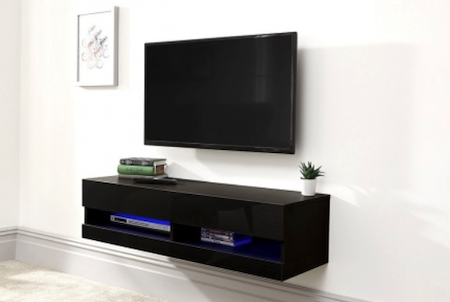How High Should A Floating TV Unit Be Off The Floor?

In the quest to create the perfect viewing experience, one question that frequently crops up is - how high should a floating TV unit be off the floor?
This simple question can have a significant impact on the overall comfort and aesthetics of your living space.
In this article, we will look into the factors that need to be considered, such as the height of your seating, the size of your TV, and the general layout of your room.
So, let's get started and help you find the ideal position for your wall-mounted, floating TV unit.
Click here to see our Contemporary Bespoke TV Media Wall Unit options.
How High Should a Floating TV Unit Be Off The Floor?
The ideal height of a floating TV unit off the floor can depend on a few factors, including the height of your seating and the size of your television.
However, a general rule of thumb is to position the centre of your TV screen at the eye level of a seated viewer.
This typically translates to having the base of the TV (and thus the top of the TV unit) around 25 inches (63.5 cm) off the floor for average seating.
However, it's crucial to remember that this is just a guideline and personal preferences or specific room characteristics may mean you choose to hang your floating TV unit slightly higher or lower.
Always ensure to measure before installation and consider the comfort of all viewers in the household.
How Do You Install a Floating TV Unit?
Installing a floating TV unit involves several key steps and requires some basic tools. Here's a simplified guide:
- Select the right spot: Choose a suitable location for your TV unit. The wall should be strong enough to support the weight of the unit and the TV. Typically, this will be a solid brick or stud wall. Avoid walls with pipework or wiring.
- Measure and mark: Measure the height at which you want to install the unit (keeping in mind the guidelines mentioned earlier) and use a pencil to mark this on the wall. Also, measure the length of the unit and mark the centre point on the wall.
- Locate wall studs: Use a stud finder to locate the studs in your wall. These are the strongest points where you should drill. Mark these points.
- Mount the bracket: Most floating TV units come with a wall bracket. Align this with your marked points and use a spirit level to ensure it's straight. Mark the drill holes.
- Drill holes: Using a drill bit suitable for your wall type (masonry for brick walls, wood bit for stud walls), drill the holes where you've marked.
- Insert wall plugs: If you're drilling into masonry, you'll need to insert wall plugs into the holes to secure the screws.
- Attach the bracket: Line up the bracket with the holes and screw it into place. Make sure it's secure.
- Attach the unit to the bracket: Finally, attach your TV unit to the wall bracket. This will often involve sliding the unit onto the bracket and securing it with screws. Check your specific unit's instructions for this step.
Remember, safety comes first.
If you're unsure about any of the steps, it's best to call in a professional.
Always check the manufacturer's instructions before beginning, as the process may vary slightly between different models.
What Are the Benefits of Floating TV Units?
Floating TV units offer a wealth of benefits that make them a popular choice for contemporary homes. Here are a few of the key advantages:
- Space-Saving: As they are wall-mounted, floating TV units free up floor space, making your room appear larger and more open. This is particularly beneficial in smaller homes or apartments where space is at a premium.
- Versatility: Floating units offer great flexibility when it comes to height placement. You can install them at the optimal viewing height for your comfort, which may not be possible with traditional floor-standing units.
- Cable Management: Many floating TV units come with built-in cable management systems. This means you can hide away unsightly wires and cables, contributing to a cleaner and more organised look.
- Stylish and Modern: Floating TV units have a contemporary aesthetic that can enhance the overall look of your living space. They come in a variety of designs and finishes, allowing you to choose one that perfectly suits your décor.
- Easy to Clean: With no legs or base on the floor, cleaning under and around a floating TV unit is a breeze. You can easily vacuum or mop the floor without having to navigate around furniture legs.
- Safety: Floating units can be a safer option in households with young children or pets as they are securely mounted to the wall, reducing the risk of the unit being accidentally knocked over.
In summary, floating TV units are a stylish, space-saving and practical solution for any home, offering a unique blend of aesthetics and functionality.
Where Can You Buy Wall-Mounted Floating Units for TVs?
Looking for a smart way to set up your TV? Try our wall-mounted floating TV units.
These units give your TV a great spot to sit, and they make your room look neat and spacious.
They also have lots of room for all your gadgets and wires. Plus, we've got different styles to match your room.
Click here to view our - Wall Mounted Floating TV Unit Options
Click here to view our - Modern Free Standing TV Units with Storage
Click here to view our - Large Free-Standing White TV Unit
Tips From an Expert
Floating units for mounting TVs make an excellent and stylish addition to a living room.
But they must be really well installed for both safety and aesthetics.
If you are not an experienced and confident DIY expert, you might want to get a professional fitter to install your unit.
Final Notes On the Ideal Height for a Floating TV Unit Be Off The Floor?
Various elements, like the height of your chairs and the size of your TV can influence the perfect height for a floating TV unit from the floor.
A common rule to follow is to place the middle of your TV screen at eye level when sitting down.
Generally, this means that the base of your TV (and therefore the top of the TV unit) should be about 25 inches (or 63.5 cm) from the floor for standard seating.
But it's important to remember that this is merely a suggestion, and your personal taste or specific features of your room might lead you to install your floating TV unit a bit higher or lower.
Always make sure to take measurements before setting up and think about the viewing comfort of everyone in the house.


